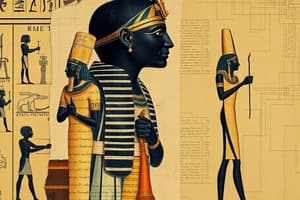Podcast
Questions and Answers
What type of artwork is prominently found in Ancient Egyptian temples and tombs?
What type of artwork is prominently found in Ancient Egyptian temples and tombs?
- Abstract sculptures of animals
- Geometric patterns on pottery
- Vibrant murals depicting daily life (correct)
- Portraits of famous leaders
Which period in Ancient Greek art saw a significant emphasis on idealized human forms?
Which period in Ancient Greek art saw a significant emphasis on idealized human forms?
- Archaic Period
- Hellenistic Period
- Classical Period (correct)
- Geometric Period
What advancement is associated with the Archaic Period of Greek art?
What advancement is associated with the Archaic Period of Greek art?
- Creation of elaborate stained glass windows
- Use of black-figure and red-figure pottery techniques
- Incorporation of dynamic emotional expressions in sculpture
- Development of naturalistic forms with kouros and kore statues (correct)
What characterizes the Hellenistic Period in Greek art?
What characterizes the Hellenistic Period in Greek art?
What is a common feature of Ancient Egyptian art that reflects their religious beliefs?
What is a common feature of Ancient Egyptian art that reflects their religious beliefs?
What characterizes the art of the Middle Kingdom period?
What characterizes the art of the Middle Kingdom period?
Which style influenced art in the Roman Period of Egyptian history?
Which style influenced art in the Roman Period of Egyptian history?
What was a significant shift in art during the New Kingdom period?
What was a significant shift in art during the New Kingdom period?
Which tool was primarily used for creating hieroglyphs on papyrus in Ancient Egypt?
Which tool was primarily used for creating hieroglyphs on papyrus in Ancient Egypt?
What was a distinctive feature of Egyptian art during the Late Period?
What was a distinctive feature of Egyptian art during the Late Period?
Flashcards are hidden until you start studying
Study Notes
Ancient Egyptian Art
- Renowned for monumental statues of pharaohs and deities, often embellished with intricate hieroglyphics.
- Tombs and temples featured vibrant murals illustrating daily life, religious rituals, and mythological themes.
- Art was highly symbolic; animals, shapes, and colors conveyed complex religious beliefs and cultural values.
Periods of Ancient Greek Art
- Geometric Period (c. 900–700 BCE): Marked by abstract geometric pottery patterns and early sculpture forms.
- Archaic Period (c. 700–500 BCE): Introduction of naturalistic forms, including kouros and kore statues, advancements in pottery techniques.
- Classical Period (c. 500–323 BCE): Emphasis on idealized human forms, realism, and architectural achievements like the Parthenon.
- Hellenistic Period (c. 323–31 BCE): Known for emotional expression and dynamic compositions, highlighted by works like the "Laocoön Group."
Key Periods of Ancient Egyptian Art
- Old Kingdom (c. 2686–2181 BCE): Characterized by monumental pyramids and statues, high formalization in art.
- Middle Kingdom (c. 2055–1650 BCE): Incorporation of early hieroglyphics and simple sculptures, along with tomb paintings reflecting daily life.
- New Kingdom (c. 1550–1070 BCE): Grand temples and vibrant murals; saw a shift to more naturalistic art in the Amarna Period.
- Late Period (c. 664–332 BCE): Blend of traditional Egyptian and Hellenistic influences post-Greek conquests.
- Roman Period (c. 30 BCE–395 CE): Integration of Roman styles, featuring realistic mummy portraits.
Tools in Ancient Egyptian Art
- Chisels and Hammers: Used for stone carving; originally copper, later bronze.
- Brushes: Made from reeds or animal hair, specifically designed for wall and papyrus painting.
- Pigments: Natural colors like ochre and malachite used with binders for painting.
- Reed Pens: Utilized for writing hieroglyphics on papyrus.
- Metalworking Tools: Bronze tools for precision work.
- Stone Abrasives: Materials like sand used for smoothing stone surfaces.
Ancient Roman Art
- Realistic Portraiture: Notable for capturing the unique features of individuals, including emperors and common people.
- Architectural Innovations: Renowned for advancements such as the use of concrete, arches, and domes, exemplified in structures like the Colosseum and Pantheon.
- Decorative Mosaics: Mastery in creating detailed mosaics that decorated public buildings and baths.
Comparisons of Egyptian, Greek, and Roman Art
- Egyptian Art: Highly symbolic, centered on the divine and afterlife themes, focusing on religious and funerary contexts.
- Greek Art: Characterized by naturalism, proportion, and idealization of the human form, inspired by the physical world.
- Roman Art: Practical and utilitarian, emphasizing architecture, engineering, and realistic portraiture, reflecting societal values.
Studying That Suits You
Use AI to generate personalized quizzes and flashcards to suit your learning preferences.




